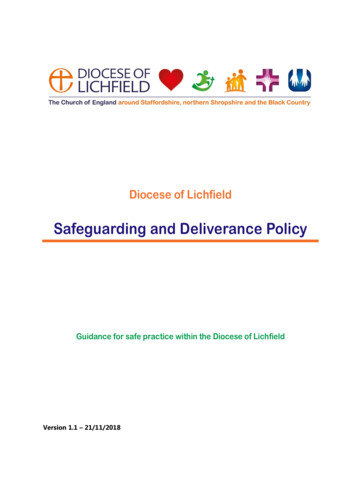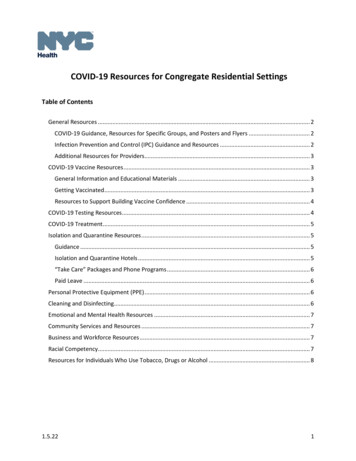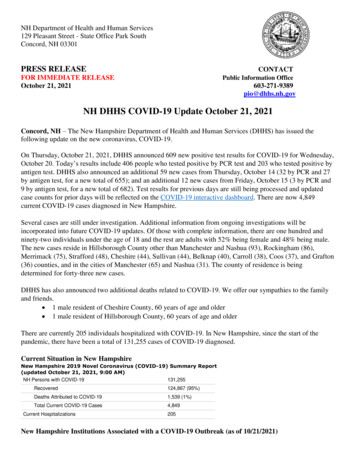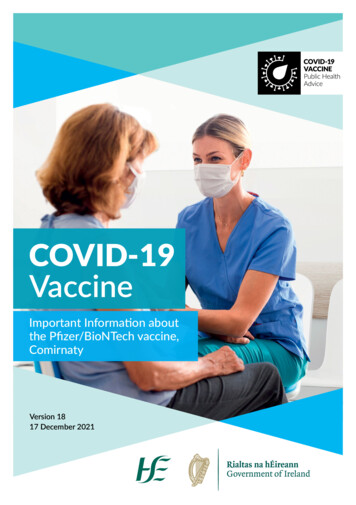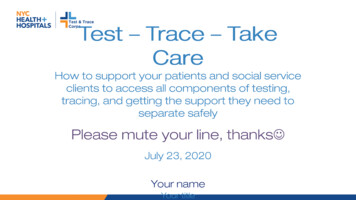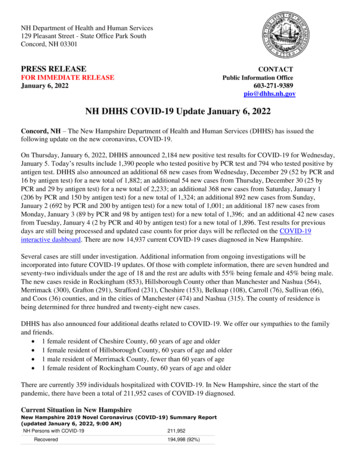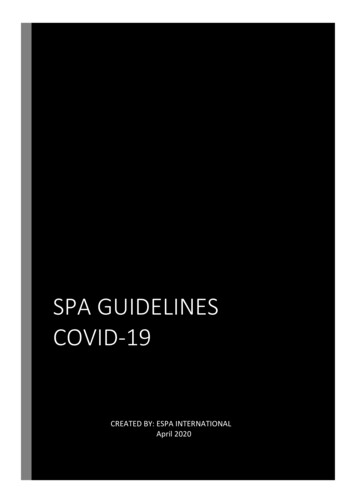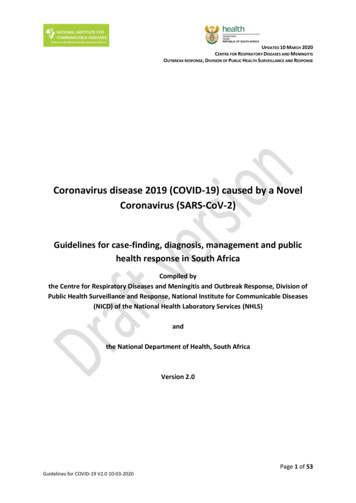
Transcription
UPDATED 10 MARCH 2020CENTRE FOR RESPIRATORY DISEASES AND MENINGITISOUTBREAK RESPONSE, DIVISION OF PUBLIC HEALTH SURVEILLANCE AND RESPONSECoronavirus disease 2019 (COVID-19) caused by a NovelCoronavirus (SARS-CoV-2)Guidelines for case-finding, diagnosis, management and publichealth response in South AfricaCompiled bythe Centre for Respiratory Diseases and Meningitis and Outbreak Response, Division ofPublic Health Surveillance and Response, National Institute for Communicable Diseases(NICD) of the National Health Laboratory Services (NHLS)andthe National Department of Health, South AfricaVersion 2.0Page 1 of 53Guidelines for COVID-19 V2.0 10-03-2020
Guidelines writing committee (in alphabetical order):Ahmed Bham (National Department of Health (NDoH), Emergency Medical Services (EMS)Jinal Bhiman ((National Institute for Communicable Diseases (NICD); Centre for RespiratoryDiseases and Meningitis (CRDM)Funeka Bongweni (NDoH, Port Health)Lucille Blumberg (NICD, Division of Public Health Surveillance and Response (DPHSR)Cheryl Cohen (NICD, CRDM)Linda Erasmus (NICD, DPHSR)Jackie Kleynhans (NICD, CRDM)Nevashan Govender (NICD, DPHSRAnn Mathews (NICD, DPHSR)Kerrigan McCarthy (NICD, DPHSR)Meredith McMorrow (U.S. Centers for Disease Control and Prevention (CDC))Jeremy Nel (Helen Joseph Hospital)Genevie Ntshoe (Helen Joseph Hospital)Wayne Ramkrishna (NDoH)Stefano Tempia (CDC)Sibongile Walaza (NICD, CRDM)Nicole Wolter (NICD, CRDM)Guideline review:This version (2.0) approved by: Cheryl Cohen and Wayne RamkrishnaDate: 08/03/2020Summary of ed byS. Walaza and MMcMorrowSummary of changes New version #2019 nCoV changed to COVID19 or SARS-CoV-2 asappropriateUpdated case counts, etc.Updated contributorsUpdated case definition to addfever, pneumonia of unknownaetiology and countries withcommunity transmission ofCOVID-191.1Page 2 of 53Guidelines for COVID-19 10-03-2020
1.18 March2020S. Walaza and M.McMorrow 2.010 March2020M. McMorrow Update information onpackaging of specimens-triplepackaging only applicable tointernational specimens)Additional information ondifferential diagnosis andtreatment addedUpdated general epidemiologicinformation on outbreakUpdated information on firstconfirmed cases in South AfricaClarified that contactinformation should be collectedfrom contacts from the date ofsymptom onsetUpdated referral hospital listMinor update to case definition2.02.1DisclaimerThe information contained in this document, be it guidelines, recommendations, diagnosticalgorithms or treatment regimens, are offered in this document in the public interest. To the bestof the knowledge of the guideline writing team, the information contained in these guidelines iscorrect. Implementation of any aspect of these guidelines remains the responsibility of theimplementing agency in so far as public health liability resides, or the responsibility of the individualclinician in the case of diagnosis or treatment.Page 3 of 53Guidelines for COVID-19 10-03-2020
Quick Reference Guide – COVID-19Criteria for person under investigation (PUI) (Page 10):Persons with acute respiratory illness with sudden onset of at least one of the following: cough, sore throat, shortness of breath or fever[ 38 C (measured) or history of fever (subjective)] irrespective of admission status ANDIn the 14 days prior to onset of symptoms, met at least one of the following epidemiological criteria: Were in close contact1 with a confirmed2 or probable3 case of SARS-CoV-2 infection; Had a history of travel to areas with local transmission of SARS-CoV-2; (NB Affected countries will change with time, consult theNICD website for current updates); Worked in, or attended a health care facility where patients with SARS-CoV-2 infections were being treated; Admitted with severe pneumonia of unknown aetiologyOROROR1Close contact: A person having had face-to-face contact or was in a closed environment with a COVID-19 case; this includes, amongst others, all persons living in the samehousehold as a COVID-19 case and, people working closely in the same environment as a case. A healthcare worker or other person providing direct care for a COVID-19case, while not wearing recommended personal protective equipment or PPE (e.g., gowns, gloves, NIOSH-certified disposable N95 respirator, eye protection). A contact inan aircraft sitting within two seats (in any direction) of the case, travel companions or persons providing care, and crew members serving in the section of the aircraft wherethe case was seated. 2 Confirmed case: A person with laboratory confirmation of SARS-CoV-2 infection, irrespective of clinical signs and symptoms. 3 Probable case: A PUI forwhom testing for SARS-CoV-2 is inconclusive (the result of the test reported by the laboratory) or who tested positive on a pan-coronavirus assay.Clinicians should also be vigilant for the possibility of atypical clinical presentations among immunocompromised patients. Consider thepossibility of influenza (Northern Hemisphere season ends in April or May) and bacterial pneumonia and manage accordingly.Infection control: Pages 10-12Laboratory diagnosis and specimen collection for SARS-CoV-2Pages 12-15, Appendices 5-8)Mode of transmission is typically respiratory droplet forhuman coronaviruses. Because patients may requireaerosol-generating procedures, airborne precautions arepreferred where possible.1. Early detection is key - healthcare workers shouldmaintain a high level of clinical suspicion2. Patients should wear a surgical mask as soon as theyare identified, and evaluated in a private room3. Isolate PUI (ideally an airborne infection isolation roomif available)4. Use appropriate infection control for PUIa. Adequate standard precautions for all patientsb. Add contact and droplet precautions for allpatientsc. Apply airborne precautions (eg. N95 mask) andeye protection must be used when performingaerosol-generating proceduresd. If available, airborne precautions should beused at all timese. Limit movement of patient (e.g. use designatedportable X-ray equipment)Collect appropriate samples. Lower respiratory tract samples arepreferred because the lower respiratory tract is the primary site ofinfection. Respiratory samples - Combined nasopharyngeal andoropharyngeal swabs in ambulatory patients and sputum and/ortracheal aspirate or bronchoalveolar lavage in patients withmore severe respiratory disease. Respiratory samples are theprimary method of diagnosis. Serum for serological testing - acute and convalescent samplesshould be submitted in addition to respiratory samples Place swabs together in universal transport medium (UTM), or ifnot available send in gel or dry, sputum and aspirates in auniversal container and clotted tube for serum Complete person under investigation form (Appendix 8) andspecimen submission form (Appendix 7) Transport samples at 2-8 C (in cooler box with ice packs) Alert NICD Hotline 27 82 883 9920A single negative test result, especially if from upper respiratory tract specimen, doesnot exclude infection. Repeat sampling and testing of lower respiratory tract samplesare recommended for cases with severe disease or in whom 2019-nCoV is stronglysuspected.Notification of cases and additional support: Appendix 4 All PUI should be notified to the district provincial communicable disease control coordinator (CDCC) as per notifiable medicalcondition procedures (see Appendix 4 and 11 for contact details), or the NICD /.Clinicians should discuss the case with doctor on call before collecting and sending specimens for testing at NICD Hot line: 2782 883 9920 or 27 66 562 4021COVID-19 is classified as Category 1 notifiable medical condition; therefore, notification should be made immediately onidentification of a case meeting case definition of person under investigation for SARS-CoV-2, a cluster of cases with severerespiratory illness with evidence of common exposure or epidemiologic link, or on receipt of a laboratory diagnosis of SARSCoV-2 infection. Information available at s/Page 4 of 53Guidelines for COVID-19 10-03-2020
1 Table of Contents1Introduction . 72Microbiology and epidemiology . 73Clinical presentation and management . 84Surveillance and case definitions for COVID-19. 104.1Rationale for surveillance for COVID-19 . 104.2Who should be tested for SARS-CoV-2? . 105Infection control. 106Laboratory diagnosis . 1276.1Who should be tested . 126.2What investigations should be done . 126.3Specimen collection and transport . 136.4Laboratory diagnostic assays and interpretation of results . 14Public health response . 167.1Response to a suspected case . 167.2Response to a confirmed case . 167.3Contact tracing . 167.4Management of the deceased . 187.5Quarantine . 188Additional Resources . 189Appendices . 199.1Appendix 1 – process flow for detection and response to cases . 209.2Appendix 2 – roles and responsibilities of facility, district, province and national vis a visinformation flow . 219.3Appendix 3 – flow diagram for contact tracing, screening and monitoring . 229.4Appendix 4 – Initial diagnosis and management of suspected case, including infectioncontrol measures . 239.5Appendix 5: Collection of nasopharyngeal and oropharyngeal swab and nasopharyngealaspirate . 249.6Appendix 6. Procedures for submission of specimens for investigation . 269.7Appendix 7 - Specimen submission form . 299.8Appendix 8– Person under investigation form . 309.9Appendix 9 – Contact tracing and contact line list . 329.10Appendix 10 – Contact monitoring tool. 359.11Appendix 11 – Response to suspected case at port of entry. 369.12 Appendix 12 – Guidelines for the safe handling of human remains of confirmed/suspectedCOVID-19 case and repatriation of human remains of confirmed/suspected COVID-19 case. 44Page 5 of 53Guidelines for COVID-19 10-03-2020
9.13Appendix 13 – Communicable Diseases Outbreak Report Format. 479.14 Appendix 14 – Contact details (email address and telephone) of stakeholders involved insupporting outbreak response. 50Page 6 of 53Guidelines for COVID-19 10-03-2020
1IntroductionOn the 31 December 2019, the World Health Organization (WHO) China country office reported acluster of pneumonia cases in Wuhan, Hubei Province of China. On 7 January 2020, the causativepathogen was identified as a novel coronavirus (SARS-CoV-2) 1. Initially person-to-person transmissionwas not apparent and the majority of the cases were epidemiologically linked to a seafood, poultryand live wildlife market (Huanan Seafood Wholesale Market) in Jianghan District of Hubei Province.However, the number of cases continued to increase rapidly, and evidence of person-to-persontransmission mounted in travellers diagnosed with coronavirus disease (COVID-19) who had visitedWuhan2.The WHO International Health Regulations Emergency Committee declared that the outbreak of 2019nCoV meets the criteria for a Public Health Emergency of International Concern (PHEIC) on 30 January2020 )). The WHO assessment of the risk of this event is: very high in el-coronavirus-2019/situation-reports.In the light of the transmissibility of coronaviruses, and the global experience with MERS-CoV(ongoing) and SARS in 2003 which were also caused by coronaviruses, South African authorities havecompiled this guideline document to support surveillance, case finding, diagnosis, management andpublic health responses to cases under investigation.THIS SITUATION IS RAPIDLY EVOLVINGBEFORE USING THIS DOCUMENT PLEASE CHECK FOR UPDATES ON THE NICD ANDNDOH WEBSITES (www.nicd.ac.za and www.ndoh.gov.za )OR CALL YOUR PROVINCIAL COMMUNICABLE DISEASE CO-ORDINATOR(See Appendix 14 for contact details)2Microbiology and epidemiologyCoronaviruses are enveloped, single-stranded positive-sense RNA viruses. The envelope of thecoronaviruses is covered with club-shaped glycoproteins which look like ‘crowns’, or ‘halos’ – hencethe name ‘coronavirus.’ Coronaviruses are responsible for the common cold, and usually cause selflimited upper respiratory tract infections. However, in 2003, a new coronavirus emerged leading tothe SARS (severe acute respiratory syndrome) outbreak. In 2012, the Middle East respiratorysyndrome (MERS) was found to be caused by a coronavirus associated with transmission from camels.Both viruses had a range of clinical presentations from mild upper respiratory tract symptoms andpossibly asymptomatic infection, to severe acute respiratory syndrome leading to sepsis, multi-organfailure and death in a sizeable proportion of cases.1World Health Organization (WHO), onavirus-2019Centers for Disease Control and Prevention (CDC), avirus-spread.html2Page 7 of 53Guidelines for COVID-19 10-03-2020
Following the identification of a cluster of pneumonia cases in Wuhan, Hubei Province of China,Chinese authorities reported on 7 January 2020 that the causative pathogen was identified as a novelcoronavirus (2019-nCoV). The gene sequences were deposited in Genbank, the NIH genetic sequencedatabase, and in the Global Initiative on Sharing All Influenza Data (GISAID) portal.Available evidence, and experience from MERS-CoV and SARS suggests that the novel coronavirus hasa possible zoonotic origin. However, human-to-human transmission of SARS-CoV-2 is now confirmed.As of 6 March 2020, over 97,000 cases and 3300 deaths have been reported from 87 countries -coronavirus-2019/situation-reports/. On 5 March2020, South African Minister of Health Dr. Zweli Mkhize announced the country’s first confirmedcoronavirus (COVID-19) case. The patient, a 38-year-old male in KwaZulu-Natal Province, returned toSouth Africa on March 1 after traveling in Italy. He developed symptoms and visited a doctor on March3 with fever, headache, malaise, sore throat and mild cough, and subsequently self-isolated. The NICDconfirmed the positive COVID-19 result and are conducting contact tracing while the patient and hisdoctor remain in self-isolation. A second case of COVID-19 was notified on 7 March 2020 in a fellowtraveller to Italy, and a third case in the same group of travellers on 8 March 2020.The Chinese Center for Disease Control and Prevention (China CDC) has provided epidemiologicalinformation on the first 44,672 cases detected in China3. Approximately 80% of cases were in personsaged 30-69 years, 10% in children and adults aged 0-29 years, and 10% in adults aged 70 years andolder. Over 80% of cases had mild symptoms, 13.8% had severe disease, and 4.7% were critically ill.There were 1023 deaths (case-fatality rate (CFR) 2.3%). The CFR was less than 0.5% in persons aged 50 years and increased with increasing age. Co-morbid conditions were reported more commonly infatal cases. Early estimates of transmission parameters are as follows (obtained from the first 425confirmed cases): mean incubation period 5.2 days (95% confidence interval [CI], 4.1 to 7.0), meanserial interval 7.5 (95%CI: 5.3-19) days and basic reproductive number 2.2 (95%CI: 1.4-3.9) 4.3Clinical presentation and managementA minority, but not negligible proportion of patients have had acute, serious respiratory illness withfever, cough, shortness of breath, and breathing difficulties. Severity of illness was defined accordingto any of the following criteria: (i) shortness of breath; (ii) respiratory rate 30 bpm in an adult; (iii)hypoxemia; and (iv) chest X-ray with multi-lobar infiltrates or pulmonary infiltration progressing 50%within 24-48 hours. Because investigations initially focused on severe cases the severity of theinfection may be overestimated among the currently known confirmed cases.The clinical features of 41 severe cases initially detected in China have been described in detail. Thesepatients were hospitalized in a dedicated hospital in Wuhan city. 73% were men, the median age was49 years (IQR: 41-58 years) and 66% had been exposed to Huanan seafood market. 32% had underlyingmedical conditions, including diabetes (20%), hypertension (15%) and cardiovascular disease (15%).Common symptoms at onset included fever (98%), cough (76%), and myalgia or fatigue (44%). Lesscommon symptoms were headache (8%), haemoptysis (5%), and diarrhoea (3%). Dyspnoea developed3Chinese Center for Disease Control and Prevention. The epidemiological characteristics of an outbreak of2019 Novel Coronavirus Diseases (COVID-19) – China, 2020. China CDC Weekly, 2020.4Li et al. Early Transmission Dynamics in Wuhan, China, of Novel Coronavirus-Infected Pneumonia, N Engl JMed, 2020.Page 8 of 53Guidelines for COVID-19 10-03-2020
in 22% of patients. The median time of dyspnoea development was 8 days (IQR: 0-13 days). 63% ofpatients had lymphopenia and all patients had pneumonia with abnormal findings on chest X-ray.Complications included acute respiratory distress syndrome (29%) and acute cardiac injury (19%). 32%of patients were admitted to an ICU and 15% died 5.Another description of the clinical characteristic of 99 confirmed cases from China reported a medianage of 55.5 years. 51% of patients had chronic diseases, 83% had fever, 82% had cough, 31% hadshortness of breath, 11% had muscle ache, 9% had confusion, 8% had headache, 5% had sore throat,4% had rhinorrhoea, 2% had chest pain, 2% had diarrhoea and 1% had nausea and vomiting. 75% ofpatients showed bilateral pneumonia, 14% showed multiple mottling and ground-glass opacity and1% had pneumothorax. 17% of patients developed acute respiratory distress syndrome and of those11% worsened rapidly and died of multiple organ failure6. More clinical information is expected toemerge if cases increase, especially among patients with mild clinical presentation.There is currently no specific treatment for disease caused by SARS-CoV-2 infection. It is important tokeep a broad differential diagnosis (bacterial pneumonia, atypical bacterial pneumonia, other viralpneumonias including influenza, or Pneumocystis jirovecii pneumonia) until diagnosis is confirmed andto provide supportive care for a Severe Acute Respiratory Illness SARI) or based on patient symptoms.Supportive management of SARI includes among others oxygen if required, ventilator support ifrequired, restrictive fluid management (unless shock or acute kidney injury), and other standardsupportive measures in critically ill patients.There is early evidence that some medications used to treat HIV (lopinavir, ritonavir) may benefitpatients with COVID-19 infection but further data are needed. The WHO interim clinical care guidancecan be found at: onavirus-2019/technicalguidance. Severe pneumonias generally require broad-spectrum antibiotics empirically and currentprotocols/guidelines should be followed 19/.Routine administration of corticosteroids should be avoided, and should only be used if, after carefulconsideration, risks outweigh benefits (eg. Adrenal insufficiency, COPD, Pneumocystis pneumonia).Although corticosteroids may be of benefit in severe bacterial pneumonias, they have been associatedwith prolonged viral shedding and increased mortality in influenzaAtypical bacterial pneumonias are an important differential diagnosis of a viral pneumonia. Like a viralpneumonia these may have flu-like symptoms and bilateral infiltrates on X-ray. Infiltrates can appearreticulonodular/patchy, not necessarily consolidation. Empiric treatment options include a Macrolide(eg. Azithromycin) OR Quinolone (eg. Levofloxacin, moxifloxacin) OR Doxycycline.Causes of viral pneumonias include influenza, parainfluenza, human metapneumovirus, respiratorysyncytial virus, adenovirus etc. Influenza is an important differential diagnosis to consider as it iscurrently influenza season in the Northern hemisphere where many COVID suspects will have comefrom and it is potentially treatable. Empiric oseltamivir (Tamiflu) or zanamivir treatment should beconsidered in patients with an influenza-like illness who are severely ill or are at high risk forcomplications (pregnant women, HIV-infected patients, patients with asthma/COPD etc). Treatmentshould be started as soon as possible, with best chance of benefit within 48 hours of symptom onset).Oseltamivir 75mg po 12-hourly for 5 days. For more information; see NICD Influenza Guidelines5Huang et al. Clinical features of patients infected with 2019 novel coronavirus in Wuhan, China. Lancet, 2020.Chen et al. Epidemiological and clinical characteristics of 99 cases of 2019 novel coronavirus pneumonia inWuhan, China: a descriptive study. Lancet, 2020.6Page 9 of 53Guidelines for COVID-19 10-03-2020
Influenza-guidelines-rev 6-June2019clean.pdf. Pneumocystis jirovecii pneumonia should be considered in patients who aresignificantly immunocompromised: HIV-positive with CD4 200, chronic systemic steroid use,chemotherapy, transplant patients, etc.) with diffuse bilateral infiltrates on X-ray (often mid to lowerzone predominance) and hypoxemia at rest (or with exertion in mild cases). Consider empirictreatment as per local guidelines if these criteria are met.4Surveillance and case definitions for COVID-194.1 Rationale for surveillance for COVID-19Surveillance for COVID-19 is essential to permit early recognition of suspected cases, early diagnosis,containment and prevention of further cases. Surveillance should be conducted by all clinicians andhealth facilities. Staff should be aware of the surveillance case definitions, and implement routinescreening where appropriate (e.g. on returning travellers from affected areas).4.2 Who should be tested for SARS-CoV-2?Surveillance case definitions for persons under investigation (PUI) who should be tested forCOVID-19Persons with acute respiratory illness with sudden onset of at least one of the following: cough, sore throat,shortness of breath or fever [ 38 C (measured) or history of fever (subjective)] irrespective of admission statusANDIn the 14 days prior to onset of symptoms, met at least one of the following epidemiological criteria: Were in close contact1 with a confirmed2 or probable3 case of SARS-CoV-2 infection; Had a history of travel to areas with local transmission of SARS-CoV-2; (NB Affected countries willchange with time, consult the NICD website for current updates); Worked in, or attended a health care facility where patients with SARS-CoV-2 infections were beingtreated;OROROR Admitted with severe pneumonia of unknown aetiologyClose contact: A person having had face-to-face contact or was in a closed environment with a COVID-19 case;this includes, amongst others, all persons living in the same household as a COVID-19 case and, people workingclosely in the same environment as a case. A healthcare worker or other person providing direct care for aCOVID-19 case, while not wearing recommended personal protective equipment or PPE (e.g., gowns, gloves,NIOSH-certified disposable N95 respirator, eye protection). A contact in an aircraft sitting within two seats (inany direction) of the case, travel companions or persons providing care, and crew members serving in the sectionof the aircraft where the case was seated.12Confirmed case: A person with laboratory confirmation of SARS-CoV-2 infection, irrespective of clinical signsand symptoms.3Probable case: A PUI for whom testing for SARS-CoV-2 is inconclusive (the result of the test reported by thelaboratory) or who tested positive on a pan-coronavirus assay.Clinicians should also be vigilant for the possibility of atypical clinical presentations among immunocompromisedpatients. Consider the possibility of influenza (Northern Hemisphere season ends in April or May) and bacterialpneumonia and manage accordingly.5Infection controlOngoing investigations are needed to more fully understand the transmissibility of SARS-CoV-2, butperson-to-person spread is occurring, and person-to-person and nosocomial transmission wascommon with MERS-CoV and SARS. The main route of transmission is through contact andPage 10 of 53Guidelines for COVID-19 10-03-2020
respiratory droplets. Airborne transmission has not been proven. The virus is excreted in stool sofaeco-oral transmission may be possible. Triage, early recognition and isolation of patients withsuspected 2019-nCoV is essential to prevent or limit transmission in healthcare settings.Based on currently available data, symptomatic cases seem to be the main driver of transmission.WHO is aware of possible transmission of SARS-CoV-2 from infected people prior to developingsymptoms. Further information is needed to better understand how transmission may haveoccurred in these few instances. Transmission from an asymptomatic person is very rare with othercoronaviruses. Persons who are symptomatic will spread the virus more readily through coughingand sneezing. Standard infection-control measures should be applied for all patients with symptoms ofacute respiratory infection including:o hand and respiratory hygieneo use of appropriate personal protective equipmento environmental and disinfection procedures should be applied For PUI: place a surgical/medical mask over the patients’ nose and mouth and evaluate in aprivate room with the door closed. implement additional contact and droplet precautions use airborne precautions (eg. N95 mask) and eye protection when performing aerosolgenerating procedures. if available, airborne precautions should be used at all times.Healthcare workers are advised to refer to the WHO interim guidance on infection prevention andcontrol during health care for suspected cases of COVID-19. This can be accessed on the WHOwebsite: se/20200126-ncov-ipc-duringhealth-care.pdf?sfvrsn 69e588ce 1&download true and will be updated as additional informationbecomes available.Key contact and droplet precautions include the following: isolate the patient (ideally an airborne infection isolation room if available, otherwiseadequately ventilated single rooms) place patient in a separate room healthcare workers to use a medical (surgical/medical) mask and eye (goggles) or facialprotection (face shield) healthcare workers should wear a clean, non-sterile, long-sleeved gown and use gloves healthcare workers should not touch their eyes, nose or mouth with potentiallycontaminated gloves or bare hands limit movement of patient (eg. use designated portable X-ray equipment) routinely cle
UPDATED 10 MARCH 2020 CENTRE FOR RESPIRATORY DISEASES AND MENINGITIS OUTBREAK RESPONSE, DIVISION OF PUBLIC HEALTH SURVEILLANCE AND RESPONSE Page 1 of 53 Guidelines for COVID-19 V2.0 10-03-2020 Coronavirus disease 2019 (COVID-19) caused by a Novel Coronavirus (SARS-CoV-2) Guidelines for case-finding, diagnosis, management and public

